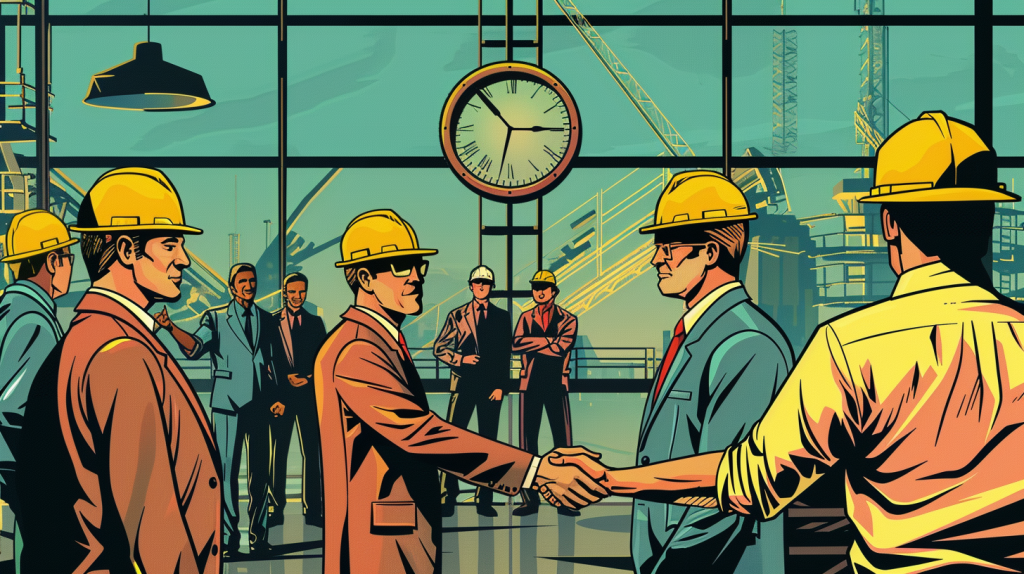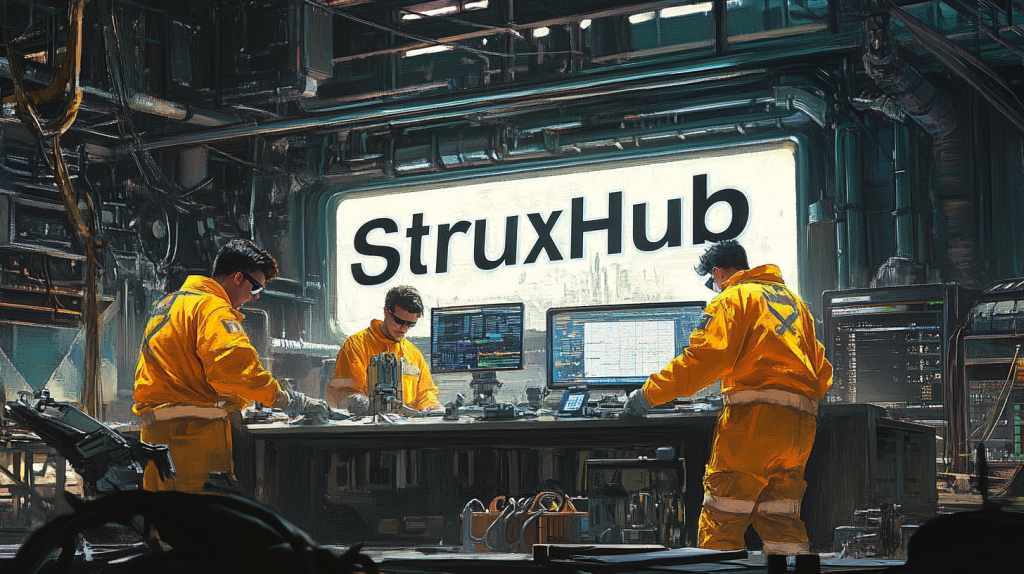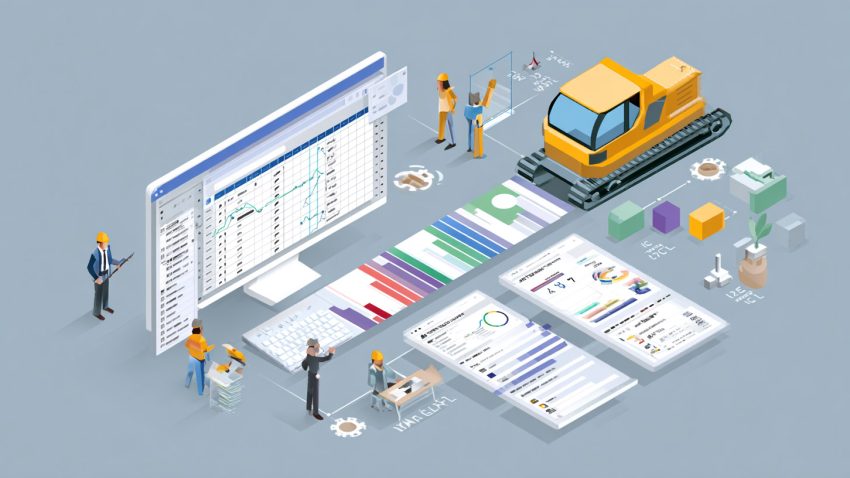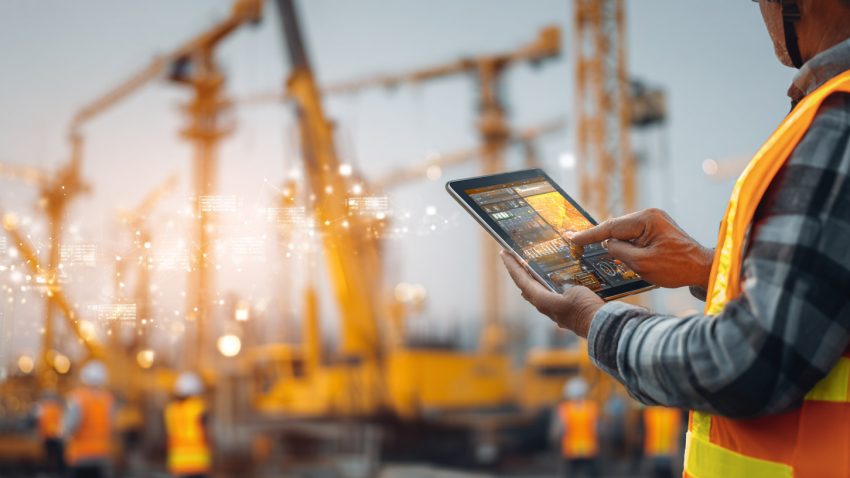The Future of Solar Construction: AI-Powered Robotics and Smart Project Management Software for Automated Site Operations
Table of Contents:

The future of solar construction is no longer a distant dream—it’s already breaking ground. As the demand for clean energy accelerates, large-scale solar projects are turning to advanced technologies like AI-powered robotics, automated site management tools, and cloud-based construction software to keep up with the pace.
Gone are the days of relying solely on clipboards and walkie-talkies to run a solar project. Today, it’s all about smart automation, real-time tracking, and machine-assisted decision-making. Superintendents, engineers, and project managers are navigating complex construction environments using intelligent platforms that connect people, machines, and data—seamlessly.
In this guide, we’ll explore how solar construction is evolving with cutting-edge technologies and how companies can leverage these tools to stay competitive, improve safety, and deliver projects faster than ever before.
How AI and Robotics Are Reshaping Solar Construction Jobsites
AI and robotics are bringing unprecedented speed and accuracy to solar construction sites. From panel placement to trenching and logistics, machines are doing the heavy lifting—both literally and computationally.
AI algorithms help forecast project delays, optimize crew schedules, and even identify safety hazards through site surveillance. Meanwhile, robotic systems are being deployed for precision-based tasks like pile driving and panel installation, especially in large-scale solar farms.
Key Benefits:
- Reduced labor costs through automation
- Improved consistency and accuracy in repetitive tasks
- 24/7 site monitoring and predictive maintenance
Best Practices:
- Start with a pilot project using semi-autonomous machines
- Train staff to operate and troubleshoot robotic equipment
- Use AI insights to support—not replace—human decision-making
AI and robotics won’t replace the skilled human workforce in solar construction, but they will transform the way we work. These technologies reduce inefficiencies, mitigate risks, and provide faster, smarter ways to build. The companies that embrace them early will have a serious competitive edge.

Smart Construction Software: The New Command Center for Solar Projects
Modern solar projects generate massive amounts of data—equipment logs, schedules, materials, compliance documents, and more. Managing it all manually is a logistical nightmare. Enter smart construction management software.
Platforms like StruxHub allow teams to automate jobsite workflows, coordinate deliveries, manage field crews, and streamline compliance from a single dashboard. These tools help superintendents manage remote solar projects without missing a beat.
Key Benefits:
- Real-time updates across all project stakeholders
- Centralized scheduling and resource tracking
- Faster decision-making through data dashboards
Best Practices:
- Choose software with strong mobile functionality
- Sync field teams and subcontractors through shared access
- Integrate with drone data, 3D models, and GIS platforms
Construction Management software is the digital brain of today’s solar sites. With smart features tailored to fast-paced, geographically dispersed solar farms, these platforms empower managers to move from reactive to proactive—and even predictive—decision-making.

Automation Tools That Are Already Revolutionizing Solar Construction
From autonomous bulldozers to robotic welders and real-time material scanners, automation is no longer experimental—it’s operational. Large-scale solar developers are already using autonomous machines to lay cable, dig trenches, and move materials with minimal human oversight.
Automation tools save time and reduce injuries, especially in repetitive or high-risk tasks. They also help projects stay on track despite workforce shortages.
Key Benefits:
- Minimizes human error in repetitive tasks
- Increases speed and throughput of installations
- Improves overall jobsite safety
Best Practices:
- Map automation use cases based on site layout and terrain
- Use machine learning to improve automated task precision over time
- Set safety boundaries and manual override systems
Automation isn’t about cutting corners—it’s about building smarter. As solar construction sites grow in size and complexity, automation tools help crews work faster, safer, and with greater precision.
Related Articles:
Floating Solar Power: Harnessing Water for the Future of Renewable Energy
Floating Solar Farms: How Offshore Photovoltaics Are Powering the Future of Clean Energy
Remote Site Management: Operating Solar Farms from Anywhere
With solar farms often located in remote or rural areas, site managers can’t always be on location. Remote site management tools—powered by IoT, AI, and mobile-friendly platforms—give supervisors full control over operations, even when they’re hundreds of miles away.
Using cloud-based platforms, construction leaders can monitor progress, approve changes, and troubleshoot issues from their smartphones or laptops. This flexibility is key in today’s hybrid workforce and multi-site operations.
Key Benefits:
- Reduces costly site visits and travel time
- Improves issue resolution time with real-time alerts
- Keeps all project data synced and accessible from anywhere
Best Practices:
- Equip your team with mobile apps for on-site data entry
- Enable geotagged photo documentation to track progress visually
- Use remote approvals and digital signoffs to keep projects moving
Remote site management tools offer a new level of control and responsiveness to solar project leaders. They help companies scale operations across multiple sites while keeping every task and update within reach.
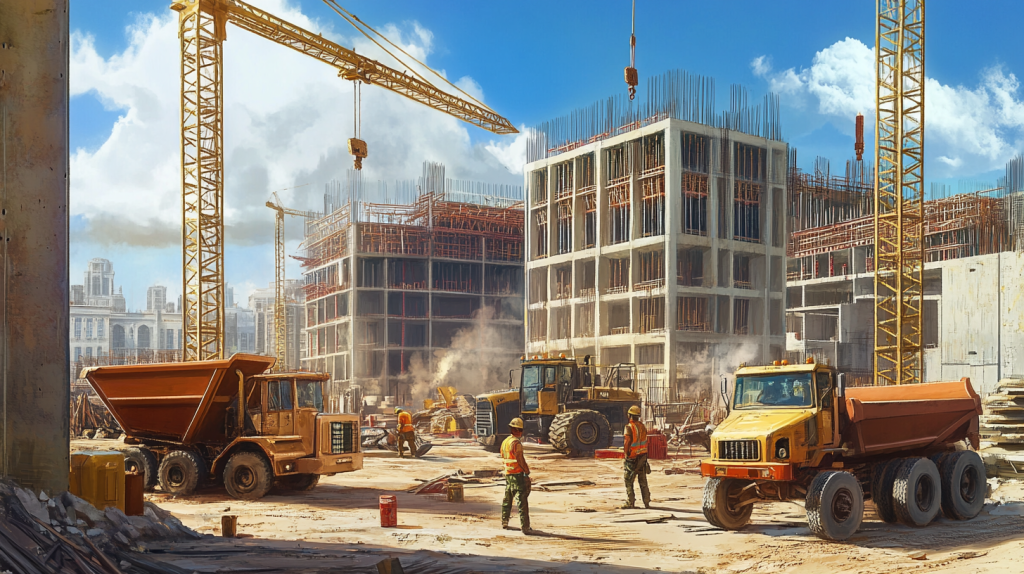
Using Drones and Aerial Data for Smarter Site Planning
Drones are becoming a standard tool in solar construction. They offer aerial views for surveying land, planning equipment staging, and inspecting work as it progresses. Combined with GIS and BIM systems, drone data can be overlaid with 3D models to visualize site development in real time.
For solar superintendents, this means better planning, less guesswork, and more accurate reporting.
Key Benefits:
- Speeds up land surveys and site assessments
- Provides up-to-date imagery for project meetings and reporting
- Enhances safety by eliminating the need for risky site walks
Best Practices:
- Fly drones at regular intervals to document progress
- Use thermal imaging to check for electrical issues post-installation
- Integrate drone data into your construction software for layered insights
Drones aren’t just fancy toys—they’re vital tools that reduce errors, save time, and keep everyone aligned. In the world of solar construction, aerial insights are a game-changer.
AI-Driven Scheduling for Solar Construction Projects
Time is everything in solar construction—especially when managing multi-phase installations across large properties. AI-driven scheduling tools are quickly becoming essential for managing solar construction timelines, resource allocation, and milestone tracking. These platforms help project managers identify potential bottlenecks, predict delays, and automatically adjust timelines to keep everything moving efficiently.
AI can analyze thousands of data points, from material lead times to crew availability and weather patterns, and recommend schedule adjustments in real time. This allows superintendents to make proactive decisions, reducing downtime and improving productivity.
Key Benefits:
- Optimized labor deployment and task sequencing
- Reduced risk of timeline slippage
- Real-time updates for crews and stakeholders
Best Practices:
- Feed the scheduling tool with accurate data early in the project
- Review AI-generated schedules weekly with your project team
- Use predictive alerts to make data-backed field decisions
AI-powered scheduling isn’t just a tech luxury—it’s a practical necessity for solar construction teams aiming to maximize resources and meet aggressive deadlines without sacrificing quality or safety.
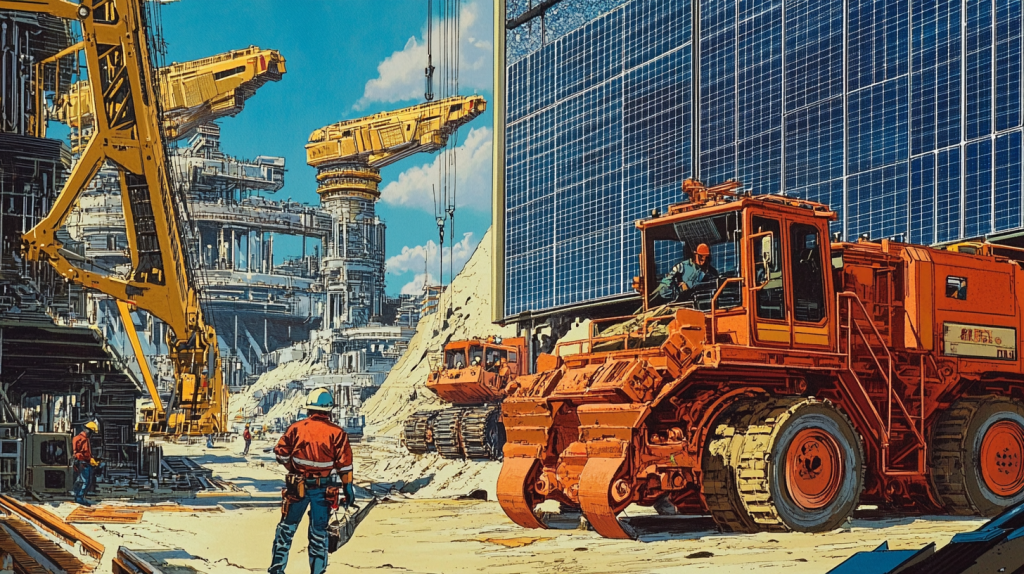
Integrating BIM with Project Management Tools in Solar Construction
Building Information Modeling (BIM) is increasingly being used in solar construction to visualize system layouts, optimize land usage, and coordinate design with execution. When paired with smart construction software, BIM allows for seamless communication between field crews, designers, and stakeholders.
By integrating BIM with your project management platform, you can access 3D models on mobile devices, link real-time progress updates to digital plans, and detect clashes before they happen—preventing costly rework and delays.
Key Benefits:
- Better coordination across design and field teams
- Fewer errors and rework due to clash detection
- Enhanced visualization of solar layouts and terrain conditions
Best Practices:
- Use BIM during the pre-construction phase to plan equipment placement
- Integrate BIM with delivery and schedule tracking tools
- Provide field teams with tablets or mobile devices to interact with 3D models
Concluding Paragraph:
BIM isn’t just for architects. In solar construction, it’s a powerful collaboration tool that helps superintendents, electricians, and field crews stay aligned from the first panel to the final inspection.
Unlock the Full Potential of Your Construction Projects with StruxHub
StruxHub enhances efficiency and coordination across all project phases, providing a single source of truth that eliminates silos and fosters collaboration. Real-time updates, financial management tools, and seamless commvunication features ensure that all team members and stakeholders are aligned and informed, reducing the risk of errors and delays. With comprehensive solutions for document management, risk mitigation, and quality control, StruxHub maintains project integrity and safety, while mobile access and integration capabilities further enhance project flexibility and efficiency.
StruxHub’s Key Features and Benefits:
- Advanced Delivery Management: Automate and optimize your delivery schedules, ensuring materials arrive just in time, every time.
- Site Communication: Utilize georeferenced maps and instant messaging to keep every team member informed and aligned.
- Construction Materials Management: Track inventory levels and manage materials procurement with ease, reducing waste and avoiding project delays.
- Construction Safety & Inspection Workflows: Implement customizable mobile forms for conducting safety inspections and managing compliance documentation effortlessly.
- Short-Term Scheduling: Visualize project tasks with detailed floor plans, linking each activity to specific locations for better planning accuracy.
- Construction Resource Management: Efficiently allocate personnel and equipment, maximizing productivity and reducing idle time.
StruxHub’s Product Offering:
- StruxHub Deliveries: Simplifies the coordination of incoming deliveries, ensuring materials and equipment are precisely timed to project needs.
- StruxHub Logistics: Offers intelligent site logistics planning, from crane scheduling to space allocation, for smoother operations.
- StruxHub Safety: Elevates on-site safety standards with easy-to-use tools for inspections, permits, and incident reporting.
- StruxHub Scheduling: Enhances project timelines with intuitive scheduling tools that ensure tasks are completed efficiently and on time.
With StruxHub, construction companies can look forward to a streamlined, more efficient project execution that delivers on time and within budget. Embrace the power of innovation and take your construction projects to the next level.
Don’t miss out on the opportunity to optimize your construction management processes with StruxHub. Sign up for a free demo today. Let’s build smarter, together.
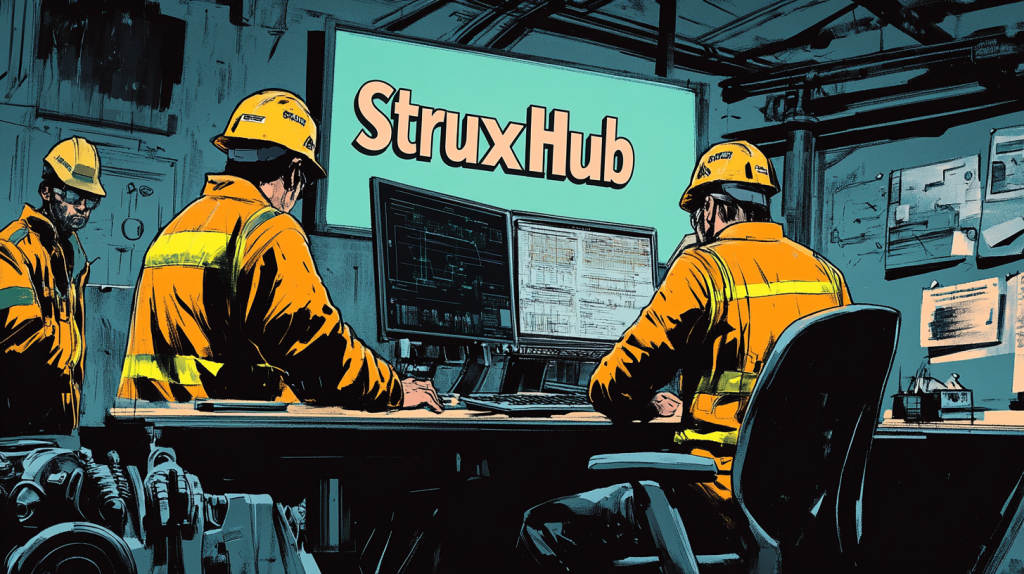
StruxHub
Experience the power of StruxHub today and witness firsthand how it can revolutionize your construction operations.
FAQ
What is AI-powered construction software and how is it used in solar projects?
AI-powered construction software uses machine learning and predictive algorithms to help project managers make smarter, faster decisions based on real-time jobsite data. In the context of solar construction, this can include everything from scheduling crews based on weather forecasts and equipment availability to predicting delays due to material shortages or regulatory hurdles.
These platforms also offer automated alerts, performance dashboards, and smart forms that reduce administrative overhead. For example, if a delivery of solar panels is delayed, the software can automatically notify stakeholders, reschedule installation teams, and adjust the overall timeline—without manual input.
More importantly, AI software learns from past projects. It can suggest optimal crew sizes, delivery sequences, and even ideal times of day for certain tasks based on performance trends. This improves overall efficiency and reduces the likelihood of human error.
As solar projects become more complex and distributed across multiple geographies, AI-powered software provides a central hub where everything—people, data, tasks, and timelines—can be tracked and managed intelligently.
How do robotics help with large-scale solar farm construction?
Robotics are revolutionizing solar farm construction by automating repetitive, physically demanding tasks that used to require large labor crews. In large-scale solar installations, robots can perform precise pile driving, panel positioning, trench digging, and even cable pulling. This not only speeds up construction but also reduces wear and tear on workers and minimizes the risk of injury.
One major benefit of robotics in solar construction is consistency. Unlike human crews who may work at varying speeds or need breaks, robots operate on a consistent schedule with high precision. This translates to faster build times and fewer mistakes in panel placement or wiring.
Additionally, robotic systems are especially useful on sites with rough terrain or difficult weather conditions. Some are equipped with sensors and cameras that allow them to navigate obstacles, detect underground utilities, or adjust their paths in real time. Others can work in low-light or high-heat conditions where human labor might be limited.
When integrated with project management software, robotic equipment can send status updates, performance metrics, and even maintenance alerts, allowing supervisors to monitor operations from a central dashboard. It’s a powerful combination of hardware and data intelligence.
Can construction software help manage compliance in solar projects?
Yes, modern construction software is an essential tool for managing compliance in solar construction projects. Solar developments are often subject to a wide range of local, state, and federal regulations—covering everything from environmental impact to electrical safety codes, workforce documentation, and material handling. Without a structured system, it’s easy to miss critical deadlines or forget mandatory reports.
Construction software centralizes all compliance-related data into one dashboard, making it easier for project managers and superintendents to track permits, inspection dates, safety trainings, and documentation required for regulatory audits. Most platforms allow you to set automated alerts so you’ll never miss an important deadline for a site inspection or permit renewal.
For example, solar sites that cross municipal boundaries may need separate permits for trenching, electrical work, or transportation logistics. A smart platform can organize these requirements by region or jurisdiction, helping teams avoid confusion or duplication. Some software even supports digital signatures and uploads of compliance certifications, reducing paperwork and saving time.
On-site crews also benefit from mobile access to compliance documents. Instead of digging through binders or emailing supervisors for clarification, team members can open the app on their phone or tablet to check installation guidelines or verify that materials meet specification. This improves accountability, reduces risk of non-compliance, and ensures that regulatory standards are met from start to finish.
In an industry where non-compliance can lead to costly fines, delays, or safety violations, having construction software tailored for solar workflows is a smart investment.
How do drones add value beyond aerial imagery in solar construction?
While aerial photos might be the most visible output from drone technology, the true value of drones in solar construction goes much deeper. Drones provide critical insights that support survey work, jobsite planning, and performance tracking—making them an indispensable tool for superintendents managing large solar projects.
One key use is in thermal imaging. After panels are installed, drones equipped with thermal cameras can scan solar arrays for hotspots, which may indicate faulty modules or improper connections. This proactive approach allows teams to identify and fix problems early—before they cause power losses or warranty issues.
Drones also enable high-resolution 3D mapping and topographical modeling. For solar farms built on uneven terrain or in remote locations, this data is essential for designing efficient layouts, optimizing panel tilt angles, and planning trenching routes for underground cables. By capturing this information before construction begins, teams can reduce errors and prevent costly rework.
During active construction, drones assist in progress documentation. Weekly or even daily flights can track the status of installations, monitor equipment usage, and provide visual proof of work completed for clients, stakeholders, or permitting agencies. When integrated with construction software, drone images can be geotagged and layered over project blueprints to highlight progress zone by zone.
Beyond improving efficiency, drones also contribute to site safety. They reduce the need for workers to climb ladders, walk active zones, or enter potentially hazardous areas just to perform inspections. All of this adds up to better planning, faster execution, and a safer construction environment.
What are the best tools for remote jobsite management in solar construction?
The best tools for remote jobsite management in solar construction are cloud-based platforms that provide real-time visibility, mobile access, and automation features tailored to fast-moving field operations. In solar projects—especially those spread across rural or remote areas—superintendents and project managers can’t always be physically present. That’s where remote jobsite tools make all the difference.
Look for platforms that combine scheduling, crew communication, delivery tracking, and document management into one integrated system. These tools allow you to monitor construction milestones, assign tasks, and manage compliance documents from a laptop or smartphone—no matter where you’re located.
For example, platforms like StruxHub enable real-time coordination between field teams and office staff. You can receive live updates when materials are delivered, access geo-tagged photos of installation progress, and approve change orders without visiting the site. Many tools also offer mobile forms for daily reports, safety checklists, and crew timesheets, all synced automatically to the central dashboard.
Other valuable features include GPS tracking for equipment and deliveries, chat or team messaging built into the platform, and integration with third-party tools like BIM models, drone data, or ERP systems. This creates a connected workflow from planning to execution to reporting.
Ultimately, the best remote management tools give superintendents complete visibility and control without needing to constantly travel between sites. They reduce miscommunication, improve jobsite accountability, and keep solar projects moving efficiently—even when spread across multiple locations.
